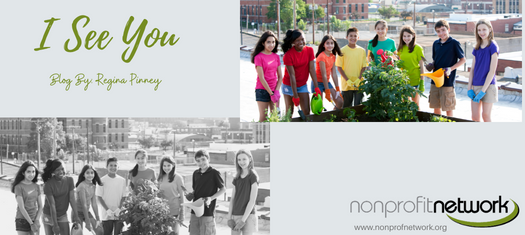
Executive Director
Being colorblind is the idea that ignoring or overlooking racial and ethnic differences promotes racial harmony. In some circles, it’s called color-evasive. In others, it is called a myth.
But we can’t not see color. We are taught in school to sort by color. We are regularly asked our favorite color. When we look at a new face the first thing we see is the color of their eyes and their appearance. In fact scientists say that the first thing we look at in a new person are all the ways we are similar. We talk about the color of our skin, we tan, color our hair, cheeks, eyelids and lips. We know what colors look good against our skin. We like colorful flowers. We use color to describe almost everything. We use it to filter our shopping choices, to help other people find something. Movie directors use color to signify relationships. We toil over the color of paint.
“Color plays a vitally important role in the world in which we live. Color can sway thinking, change actions, and cause reactions. It can irritate or soothe your eyes, raise your blood pressure or suppress your appetite,” says a popular graphic design resource.
In nature, we use our color to attract a mate, the more bold, and pretty the more likely it is we will attract our suitor. Color is all around us and beautifies our environment.
But – let's ignore all of that when it comes to people of color?
Research shows that we don’t like to talk about the color of ones skin because it makes some of us uncomfortable. These studies show when we teach colorblindness, we are teaching our children that we do not have to accept or acknowledge the impacts of prejudice and racism.
For centuries, the color of one’s skin determined everything –where you could live, where you could go to school, if you could get a job, if you could be out past dark, who you could date and who you could marry. In fact, a study completed in 2006 found that realtors were still steering white buyers to white neighborhoods and black buyers to black neighborhoods.
When we pretend not to see, we can’t talk about our differences. If we can’t talk about it, we then struggle to learn about or understand our differences. And we will continue to fear and make up stories in our heads (reinforce bias and stereotypes) about things we don’t understand instead of celebrate, embrace, and be inclusive in our differences.
Color matters.
Why? We like differences in lots of other ways – differences can enrich our lives. We like different foods and music. We like to share recipes. We like to know where people were born and where they grew up. Opposites attract. We like to know about people’s traditions and heritages. We like to know it all – except how the color of someone's skin has impacted their life.
Being color blind (I don't see color) allows some to ignore the significant effects of racism that occur every day. Multiple studies show that racism is causing significant health issues like post-traumatic stress disorder. These equated constant racial macroaggressions produce the same trauma as experiencing violent crime.
Imagine if our doctors didn't note our color, our health will suffer. Race and lifestyle are incredibly important when it comes to diagnosing symptoms and preventative care.
How is this relevant to the nonprofit sector? When we do not see color, we miss critical information that would help us attract, connect with, and recruit donors, board members, and serve clients.
Differences are important and allow us to customize how we work in order to be more effective and more impactful.
Inclusive design strategies, like Human Centered Design, have been proven to produce better outcomes because we create programs based on the needs of our community and who we serve.
Let’s replace color blindness with color appreciation. We should all be proud of who we are. Let's embrace and enjoy our differences. Color makes us beautiful.
If your organization needs help with diversity, equity, and inclusion work, feel free to reach out to us, it's what we do. You can also visit our Diversity, Inclusion, & Equity page for free tools. And as always, we’re here to help you make the world a better, safer, and more equitable place. Call 517-796-4750 or email us today! We're happy to help!
Want more? Click here to sign up for our weekly e-newsletter. Each week you'll get a link to the most recent news, workshops, and blog post. We promise to respect your time and will not flood your inbox. We only send one newsletter email each week and when any timely important announcements need to be made.
*Adapted from June 2022


